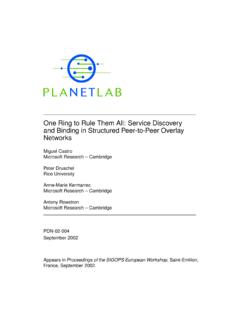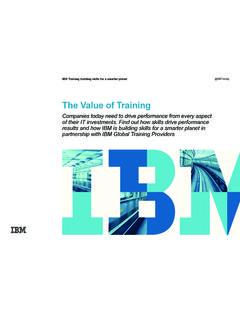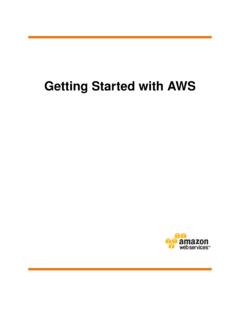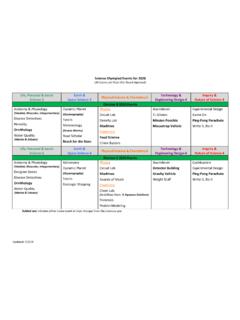Transcription of PlanetLab Version 3
1 PlanetLab Version Marc Fiuczynski, Mark Huang, Aaron Klingaman, Steve Muir, Larry Peterson, Mike Wawrzoniak Princeton University PDN 04 023. August 2004 (updated January 2005). Status: Ongoing Draft. PlanetLab : Version T. Marc Fiuczynski Mark Huang Aaron Klingaman Steve Muir Larry Peterson Mike Wawrzoniak January 27, 2005. 1 Introduction AF. This document describes the design, interfaces, and rollout of Version of the PlanetLab software. The new features included in Version are largely a response to discussions on the architecture mailing list over the last year, with many of the issues captured in PDN-04-17.
2 Specifically, Version is designed to: Support alternative brokerage services, allowing them to acquire resources and create slices with minimal involvement from PLC. Support alternative environment services, allowing them to download and manage software packages on behalf of client slices. Support stronger resource isolation, including the ability to manipulate resource assignments from both the GUI and the programmatic interface. Uncouple the PLC database from the interface used to create and manipulate slices, in anticipation of future decentralization of PlanetLab .
3 We have also taken this opportunity to re-organize the database to better match our current model of roles, sites, services, and so on. Support stock ping and tcpdump binaries, meaning that the new implementation of safe raw sockets is compatible with the standard socket API. Network virtualization is also enhanced to support the require- ments of new services ( , network telescope and GRE tunneling). DR. Address the long-term issue of kernel maintenance, including our ability to track new kernel versions with extensive local modifications. We also need to resolve the limitations of depending on the RedHat distribution.
4 Version includes the following major components: PLC. 1. reorganized database programmatic interface Web/GUI. Node Manager T. support for stronger resource isolation support for local sliver instantiation support for privileged operations (Proper). Kernel Linux Vservers AF CKRM E15. VNET Installer BootCD. package management Note that while some of the new capabilities mentioned above are supported by a single component, in most cases, support for a given feature spans multiple components. For example, support for stronger resource isolation requires changes to the database (to record resource allocations for a given slice), the programmatic interface (to allow PIs and administrators to set a given slice's allocation), the node manager (to control the kernel's allocators and schedulers), and the kernel (to enforce the allocations).
5 Moreover, Version defines very little about the policies, and primarily involves providing an flexible framework that can be evolved over time. 2 PLC. DR. Several software components running at PlanetLab Central (PLC) collectively provide an interface to the Plan- etLab infrastructure. Few new capabilities, per se, have been added to this software, but it has been significantly reorganized to better support the evolution of the rest of the system. At the heart of PLC is a database, which is organized into two components: (1) administrative information primarily about sites, users, and nodes; and (2) information about slices running on the infrastructure.
6 For the purpose of this discussion, we treat these as two separate databases, called the AdminDB and the SliceDB, respectively, although in practice they are as a single database. 2. A major shift in Version is that all manipulation of the PLC database will be done through a programmatic interface. The GUI running at the PLC website will use this interface, as will those sites and services that wish to directly manipulate the database. The interface can be viewed as having two largely independent pieces, corresponding to the AdminDB and SliceDB. Generally speaking, operations that manipulate the SliceDB are available to all PlanetLab users, while T.
7 Operations that manipulate the AdminDB are available to users whose roles allow them. For example, users can modify their own accounts, while PIs can modify any user at their site. Slice API. Starting with Version , users have been able to create slices using a programmatic API (XMLRPC based). rather than through the GUI available at the PlanetLab web site. Among other things, this allows alternative slice creation services to evolve. Version of this interface adds two new features. The first is support for requesting a ticket that can later AF. be redeemed at individual PlanetLab nodes to create a local sliver.
8 This allows slice creation services to directly interact with node managers rather than have to create slices centrally through PLC. (PLC still supports a default slice creation mechanism.) The second feature allows users and site PIs to specify additional slice attributes such as resources ( , CPU shares, link bandwidth, disk quotas, and so on) or slice-specific initialization scripts to be bound to particular slices. The interface itself is designed to be extensible, with support for new resource types being incrementally added as the rest of the system permits ( , as soon as appropriate schedulers and allocators are available on individual nodes).
9 Note that to enable these features, the programmatic interface had to first be re-implemented. We elected to implement it in python; the original Version was written in php. The new implementation also implements a backward compatibility module with the dynamic slice API (not discussed here). Information about the specific slice operations can be found on-line at Admin API. The AdminDB has grown in a rather ad hoc way since PlanetLab was first deployed. With Version , we substantially reorganized this database to reflect the way PlanetLab is actually administered. Major changes include: Support for people being members of multiple sites and having multiple keys.
10 DR. Support for logical node groups, making it easier to handle custom configurations for particular subsets of nodes; , an Internet2 group, an alpha node group, and a beta node group. Support for organizations, which can span a of groups of sites, rather than just a single site. Support for tracking deleted accounts, as well as nodes and sites that are no longer in use. Moreover, the AdminDB is now accessible via a programmatic interface. The methods used to access and manipulate the AdminDB are currently described on-line at 3. Web GUI. The website interface now interacts with the AdminDB and SliceDB via the programmatic interface.




